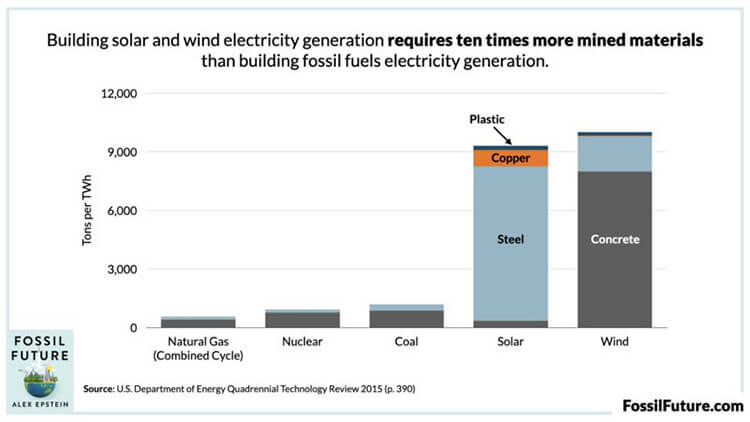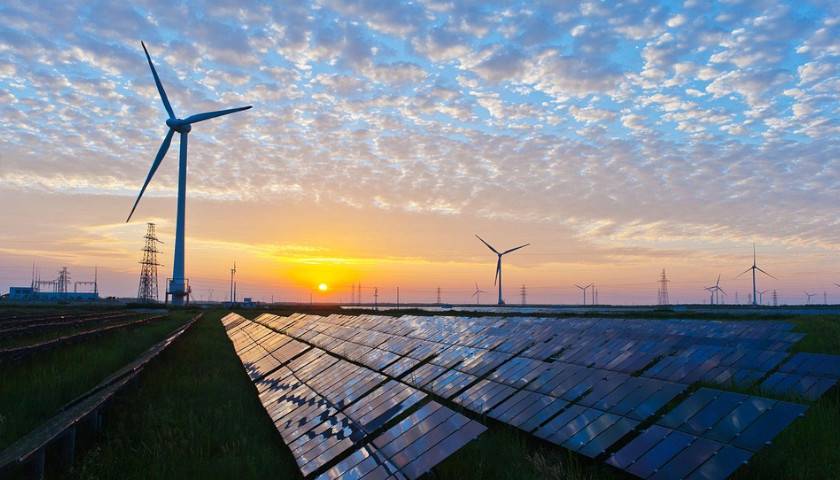by Edward Ring
Today in America, there are obvious disconnects between observable reality and the narratives we get from the corporate special interests controlling the news we consume, along with politicians who are supposedly elected to represent us.
This is nothing new. Elites have defined America’s destiny throughout its history. The only difference today is that the internet, despite ongoing crackdowns, still manages to deliver an unprecedented volume of contrarian perspectives to millions of people. We aren’t any freer or less manipulated today than we ever were, we’re just more aware of it.
What may be different today, however, is the misanthropic folly of America’s current energy policies. America’s ruling elites are not only imposing these policies on everyone living here, they are attempting to impose them everywhere on earth.
By now it should be beyond serious debate that “renewable” energy cannot possibly scale adequately to replace fossil fuels. Worse still, renewable energy systems are even less sustainable than fossil fuels and cause more environmental destruction. Renewables also fail to offer significant reductions in carbon emissions, and in some cases actually cause more carbon emissions.
Why these facts are dismissed by America’s elites is a story of corruption, collusion, megalomania, greed, cowardice, intellectual negligence, and delusional mass psychosis. Modern political theory offers solace to cynics who believe all democracies are actually just “managed” shams by suggesting pluralism and representative government are nonetheless at least approximated if there is competition among the powerful elites running a nation. But what if there is no interelite competition in the realm of ideas? What happens when every one of these elites believes the same things? When it comes to “renewables” and “net zero by 2050,” that’s what we have in America today.
As a result, Americans face a future of perpetual scarcity: rationed, algorithmically micro-managed access to energy, punitive pricing for energy use over government mandated thresholds, and a wasteland of landscapes ruined by solar farms, wind farms, battery farms, distribution lines, open pit mines, evaporation ponds, and dumps; all the destructive consequences of industrial scale “renewables” development. At this rate, the blind rush to eliminate fossil fuel and rely solely on renewables will cause catastrophic worldwide shortages of energy, spawning deadly poverty and desperate wars.
Renewables Are Not Renewable
A recent post by respected investment blogger Wolf Richter, compiling data from the Energy Information Administration, reported “renewables” generated 22.6 percent of all U.S. electricity in 2022, a record high. Proponents of renewables consider this achievement as validating their strategy. But the devil is in the details.
To begin with, hydropower accounted for 6.1 percent of that total. But hydropower is under relentless assault by environmentalists, and even if more hydroelectric dams could be built instead of demolished – which is the current trend – the best sites have already been developed.
But what about wind, which contributed 10.1 percent of all electricity generated in 2022, and solar, which added another 4.8 percent?
To put the question into relevant context, first consider what it’s going to take to get America’s economy to a “net zero” state by relying solely on wind and solar. To do this, we cannot merely calculate how much additional wind and solar generating capacity would be necessary to replace all other sources of electricity generation in the United States. The residential, commercial, industrial, and transportation sectors of the U.S. economy rely on direct inputs of natural gas and petroleum for 62 percent of the energy they require. Electricity is only used for the remaining 38 percent, which means at 14.9 percent of that, wind and solar actually only delivered 5.7 percent of all energy consumed in the United States in 2022.
Merely electrifying the transportation sector in the United States would require total electricity generation to nearly double. To electrify the entire U.S. economy would require total electrical generation to triple. To do this using only wind and solar power would require the current installed base of wind and solar to expand by a factor of 18 times, and the process would involve far more than erecting 18 times more wind turbines and solar farms than we have already. There remains as well what is euphemistically called “balance of plant.”
In the case of wind and solar, balance of plant refers to thousands of miles of additional high voltage power lines and utility-scale battery backup systems. Since most parts of the United States, such as the densely populated Northeast, do not have reliable solar energy and are not the windiest parts of the country, it would be necessary to transmit wind energy from the plains states, and solar power from the southern latitudes. At the same time, hundreds, if not thousands of gigawatt-hours of battery storage would be required.
Peter Ziehan, an economist whose new book The End of the World Is Just the Beginning should be mandatory reading for anyone promoting renewables, had this to say about relying on wind and solar power, along with transmission lines and battery backup: “Such infrastructure would be on the scale and scope that humanity has not yet attempted.”
The Resources Required for Renewable Energy
One of the most prolific and persuasive advocates for a realistic energy strategy in the U.S. is Alex Epstein, whose latest book Fossil Future, makes a compelling case for why the benefits of using fossil fuel far outweigh the costs, including the environmental costs. Using data from the U.S. Department of Energy, he produced the following chart, which ought to make plain the devastation – and complete unsustainability – of so-called renewable power.

Epstein’s analysis employs “tons per terawatt-hour,” referring to the tons of raw materials required to construct various forms of electricity-producing generating plants; natural gas, nuclear, coal, solar, and wind. As the chart above shows, to generate the same amount of electricity, building a natural gas power plant uses only a small fraction of the raw materials required for a solar or wind system. The magnitude of the stress solar and wind would put onto mining operations is evident when calculating what it would take for them to power the entire United States, or the entire world.
If the entire U.S. annual consumption of energy were expressed in terawatt-hours, that is, if every economic sector of the United States were electrified it would take 28,500 terawatt-hours, based on the most recent data. That would equate to solar and wind farms consuming approximately 256 million tons of concrete and steel. The entire U.S. steel production in 2021 was 86 million tons. The entire U.S. cement production in 2021 was 80 million tons.
Then there’s the copper, which for solar requires about 1,000 tons per terawatt-hour. This means if 50 percent of the renewables required to electrify the entire U.S. economy were via solar power, 14 million tons would be required. Total U.S. copper production is only 1.3 million tons per year. This much new solar energy capacity would use up 100 percent of our entire production of copper for 11 years.
This only begins to describe the environmental toll “renewables” are poised to inflict on the planet. What about the fact that for every person on earth to consume just half as much energy per capita that Americans consume, global energy production would need to double? To do that with wind and solar would require roughly 3 billion tons of cement and steel, and well over 100 million tons of copper. Have the renewables advocates thought this through?
All conventional power plant alternatives, using gas, nuclear and coal, require one-tenth or less raw materials to generate an equivalent quantity of electricity. For modern natural gas combined cycle generating plants, the ratio is closer to 1/20th as much raw inputs. But when it comes to solar and wind power, which is distributed and intermittent, what about the transmission lines and the batteries? What about the service life of all this installed base, the solar panels and batteries and wind turbines that degrade after 20 years and have to be decommissioned, recycled and replaced? What about the environmental costs of extending this resource guzzling scheme to every nation on earth?
Electric Vehicles Are Not Sustainable
When discussing the sustainability of renewables, of course, an honest analysis cannot focus exclusively on the production side. If the energy consumption of an entire economy is electrified, that would include the transportation sector, where in every significant case the goal of electrification is fraught with challenges. Ships at sea cannot recharge their batteries during a four week voyage on the deep ocean. Can they use hydrogen fuel cells instead? Can they go back to relying on sails?
Farm equipment that is too expensive to leave idle during harvests must operate up to 18 hours a day, so how will they recharge in only six hours? Will they swap batteries in the middle of a shift? Perhaps solutions exist. But they are expensive and they squander resources.
It is the ubiquitous automobile, at last count numbering 291 million in the United States alone, where “renewable” technology is most readily exposed as incredibly wasteful and destructive to the environment. Peter Zeihan explains what it takes to build an all-electric vehicle: “You think going to war for oil was bad? Materials inputs for just the drivetrain of an EV are six times what’s required for an internal combustion engine. If we’re truly serious about a green transition that will electrify everything, our consumption of all these materials and more must increase by more than an order of magnitude.”
Not just the environmental, but the human impact of replacing hundreds of millions of conventional automobiles with EVs is outlined in a scathing new book by Siddharth Kara, Cobalt Red: How the Blood of the Congo Powers Our Lives. When every supply chain on earth, egged on by the “climate crisis,” is furiously bulking up to source raw materials at 10 times the rate they’d previously required, abuse is inevitable.
The tragedy playing out in the Democratic Republic of the Congo to feed cobalt to the “green” West is almost apocalyptic. Kara describes how private militias control mining areas with child slaves picking their way through toxic pits in subhuman conditions. Environmental regulations are nonexistent. Human rights are nonexistent. This appalling drama repeats itself around the world, at the same time as slick television commercials market electric vehicles to Americans as a virtuous choice.
So What Are Some Alternatives?
Current responses to the climate change “crisis” are not serving the interests of people or the environment. Even if every terrifying climate prediction were accurate, most nations of the world are not going to stop developing fossil fuel because, as we have seen, it is impossible to replace based on any existing technologies.
For this reason, the money being directed to retooling the entire energy sector to adopt “renewables” should be redirected to research and commercialize breakthrough technologies. Maybe direct synthesis of carbon dioxide into liquid fuel, or fusion power, or factory farmed high-yield biofuel from algae. Maybe something we can’t yet imagine. If politicians are panicked over climate change, put money into research. Because today’s renewable energy technology will destroy the planet and the people.
There is an upside to green technology when it is commercially competitive. Hybrid SUVs, which carry a small battery and electric motor to recover energy from braking and downhill coasting can get 40 miles per gallon. Advanced hybrids that might utilize onboard generators, natural gas internal combustion engines, and smaller batteries, could deliver much higher fuel efficiency. So why has California banned emerging hybrid technologies, instead mandating that new cars have no combustion engines whatsoever?
Similarly, there are places where an all-of-the-above energy strategy can make commercial sense, but those places are limited. One of the reasons natural gas power plants are inaccurately stigmatized as not cost-competitive with solar power is because on grids with a large installed base of renewables these plants are only fired up when the sun goes down and the wind stops blowing, meaning their ability to earn revenue is cut in half, even though the cost to build them remains the same.
Rapidly forcing current renewable energy technology onto the American economy comes with staggering opportunity costs. The trillions of dollars in public and private investment could be redirected to upgrade badly neglected existing infrastructure and build new and cost-effective conventional infrastructure in order to deliver abundant energy, water, and transportation assets to the American people. These investments in practical infrastructure during the 1930s and again in the 1950s and ’60s constituted the enabling foundation for an explosion in manufacturing productivity, well paying jobs, and affordable market housing.
There is a demographic irony here that renewables advocates fail to appreciate. Prosperous nations are experiencing unsustainably low birthrates because despite freedom from basic hunger, manufactured scarcity has made it necessary for both parents to work just to spend most of their income making mortgage payments on a ridiculously overpriced home. Many have to live in apartments and condominiums where nobody wants to raise children. When it comes to being able to form families, prosperity in developed nations is an illusion. Only with practical infrastructure development will the cost-of-living descend to the point where people in prosperous nations will again choose to start families.
At the same time, in poor nations where labor intensive subsistence farming and child labor are how families survive, birth rates remain unsustainably high. Delivering cost-effective energy and infrastructure solutions to these nations will bring their birth rates down, as it has all over the world. Delivering “renewables,” on the other hand, forces both parents to keep working in developed nations, and condemns the people living in poor nations – during even the slightest blip in imported aid – to strip the forests bare for fuel and exterminate the wild and endangered game for protein. That’s the green world fully realized. It’s a dismal scenario.
Renewables in their current form will never deliver enough energy to sustain a prosperous human civilization. But they will destroy the earth. Wind farms, onshore and offshore, wreak havoc with insect, avian and marine life, and building them will consume more cement than the world can possibly supply. Solar farms consume vast amounts of open land – where, paradoxically, environmentalists prohibit anyone from building to increase the supply of homes – and they will consume more steel and copper than the world can possibly supply. The same goes for EVs, batteries, and new high voltage transmission lines. In exchange for displacing less than two percent of oil production, biofuel crops already consume 500,000 square miles; pesticide, herbicide, and fertilizer saturated monocrops abound where there were once rainforests or diversified farmland.
The pillaging of the earth to source raw materials for renewables will make the current impact of human civilization on the environment trivial by comparison. In a wealthy nation like America, mandated renewables will complete the destruction of the middle class and will consolidate the power of the surveillance state. If renewables are imposed on poor nations, they will lead to poverty, war, and famine on a scale never seen in human history.
Critics of the renewables mania correctly identify climate crisis passions as a new popular religion for a post-modern culture that has lost its way. But it is the elites who have truly lost their way. They have not only transmuted their natural human need for meaning and purpose into embracing the green religion, but they have become so intoxicated with their wealth and power that they have convinced themselves they are uniquely qualified to control the destiny of the world. They have forgotten the lessons of history. Lost in their own hubris, they are taking this beautiful world and everyone on it straight to hell.
– – –
Edward Ring is a senior fellow of the Center for American Greatness. He is also is a contributing editor and senior fellow with the California Policy Center, which he co-founded in 2013 and served as its first president. Ring is the author of Fixing California: Abundance, Pragmatism, Optimism (2021) and The Abundance Choice: Our Fight for More Water in California (2022).




